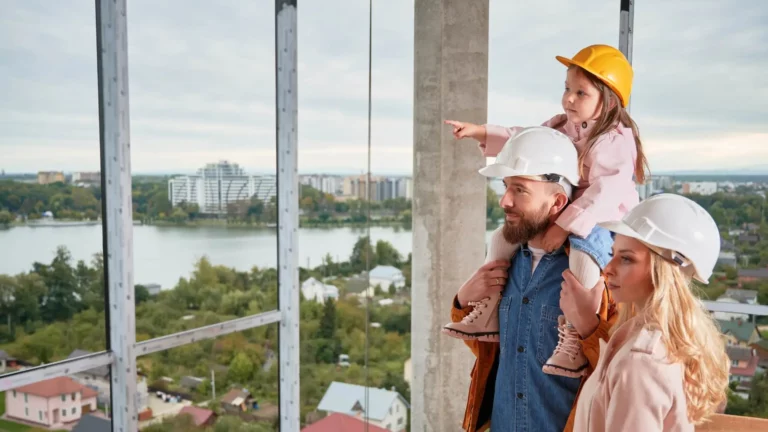Table of Contents
No matter how much you earn or save, building a home is a big financial commitment and will leave a dent in your expenditure. So, finding ways to save as construction costs rise is vital. In 2022, the average cost of constructing a single-family home in America was about $392,000. But, building a house now costs almost $100,000 more than in 2019, according to Statista. Let’s explore how to save money on building a house.
How to Save Money on Building a House
With the cost of building a new home rising, it is essential to save money while still achieving your dream home. This guide will teach you how to save money on building a house by listing tips to lower costs.
Rising Construction Costs
The construction sector has seen rising material and labor costs in recent years. Prices have risen for everything from wood for interiors to iron sheets for roofs. Building homes is now more costly. Supply chain issues, rising demand, and inflation have driven this surge. Understanding these rising costs is a crucial factor in budgeting. It helps in finding ways to save.
Why You Need to Budget for a New Home
Without proper financial plans, expenses can spiral out of control, leading to strained finances and incomplete projects. By planning your budget, you manage your debts and help ensure that you can afford the house you want without giving up vital aspects.
Overview of Potential Cost-Saving Strategies
When saving money during home construction, strategic planning, smart material choices, and efficient project management are vital to this goal. Focusing on critical points like planning, materials, labor, or funding can lower overall costs.
Planning and Design
Planning and design set the stage for a successful home-building project. These first steps significantly affect your total costs and how you want things done.
Creating a realistic budget
Before delving into the design details, define a clear and realistic budget. In addition to construction costs, other expenses to factor in include permits, closing costs, and furniture.
Choosing a suitable lot location
Your house’s location will influence its overall value and your daily life. Consider its nearness to amenities such as schools, a transport system, and the desired community feel.
Selecting a cost-effective home plan
The size or complexity of your house plan dramatically affects the building bill. Efficiency through smaller houses can mean thousands of dollars saved. Invest in two-story designs that save on space without increasing the floor area.
Prioritizing essential features
Focus on what is significant to you and your family’s lifestyle. This means considering essentials such as bedrooms, kitchens, and bathrooms while including extras like a gourmet or home theatre for future fancy additions.
DIY design elements
If you have a flair for creativity and design ability, consider doing some DIY style elements yourself. Custom built-in shelves, interior painting, or choosing light fixtures can save bucks while giving a personal touch.

Building Materials and Labor
The cost of materials and labor accounts for a large chunk of the overall construction budget. However, you can significantly reduce expenses in this area by making informed choices and implementing smart strategies.
Comparing building material costs
So, before committing, it is better to examine the costs of various building materials carefully. Compare prices from different suppliers to identify potential savings. Consider things like the durability of the material, maintenance needs, and long-term value while choosing.
Opting for cost-effective materials
Selecting cost-effective materials with durability and aesthetic appeal is critical to reducing construction costs. Consider materials such as engineered wood, recycled metal, or concrete, which may be more affordable yet maintain their quality levels.
Hiring skilled but affordable contractors
Labor makes up a significant part of your construction budget. If quality is not compromised, employ skilled but affordable constructors to save money. Obtain quotes and references from past clients before hiring contractors to get value for money.
DIY tasks and labor savings
If you can, consider doing some tasks yourself. It will cut your labor costs. Homeowners can save thousands by painting, landscaping, or carpentry.
Negotiating with suppliers
Don’t feel shy about bargaining with suppliers for discounts or bulk pricing. A personal relationship with local suppliers often results in good deals, especially if you buy bulk from them.
Construction Process
The momentous stage where effective management occurs is the construction phase, which determines whether your project will stay within budgetary limits.
Efficient project management
Keeping communication channels open between yourself and your contractor and establishing realistic timelines are crucial for facilitating a smooth flow during construction. Regular site visits and detailed progress reports ensure everything goes according to plan.
Building during off-peak seasons
Construction costs vary throughout the year. Building during the off-season (usually winter in most areas) often means cheaper materials and labor.
Avoiding change orders
Furthermore, change orders, which mean alterations to the original construction plan, usually incur higher costs. To avoid this, ensure your plans are finalized before construction begins and stick to the agreed-upon design.
Energy-efficient design and materials
Energy-efficient design and materials can save much on utility bills in the long run. Insulation, energy-efficient windows, and renewable energy can make a home sustainable and cost-effective.
Utilizing prefabricated components
Prefabricated components save time and money. They are often cheaper than custom-built ones, yet they can be assembled quickly, lowering labor expenses.
Financing and Budgeting
Financial planning is typically a critical element for successful home-building. It will help you manage your finances and avoid financial stress.
Secure a competitive mortgage rate
In contrast, it is imperative to find the best mortgage lender so that you may save a significant amount of money over the life of your loan.
Understanding construction loans
Understanding the terms under which these loans operate becomes essential when attempting to keep within one’s budget or funding for building activities.
Creating a detailed budget
During construction, having a detailed budget and keeping track of all expenses is necessary. Reviewing your budget regularly will enable you to stay on course without overspending.
Tracking expenses and sticking to the plan
Real-time expense tracking allows you to check where your hard-earned cash disappears so that corrective measures may be taken.
Government incentives and rebates
Some government initiatives provide rewards and concessions for those constructing environmentally friendly homes or utilizing renewable materials. Research these programs to enjoy any cost reductions they guarantee.
If you are looking for the right way to manage your construction expenses, Beem is here to help. You can download the Beem app here.
Additional Savings Tips
The following tips help increase your savings while ensuring you reach your home-building objectives.
Building in phases
Having your house constructed in steps makes it easier to manage the related finances as the expenses are spread over time. It allows one to start with the essential areas and complete construction later when resources allow it.
Considering modular or prefab homes
Compared to regular constructions, modular homes are cheaper options. These homes are constructed somewhere away from where they will finally stand, reducing construction time and workforce costs.
Utilizing recycled or reclaimed materials
To save on building costs, home builders may choose environmentally friendly methods, such as using recycled products. Constructive materials made from waste can improve a home’s appeal, thus reducing future demand for fresh materials.
Seeking professional advice
Consulting professionals such as architects, contractors, and financial advisors, among others, would enable one to identify areas for savings and aid in project completion within budgetary limits.
Negotiating with subcontractors
Negotiating for better rates with subcontractors is also a way to save significant amounts of money. Fostering strong ties with these individuals will make it easy to do business while demanding higher-quality services.
Read more: How To Save Money For A House In 6 Months
Conclusion
Building a house is expensive, but it can be achieved with a proper budget and strategy without compromising quality. Following this guide will help you master how to save money on building a house. Remember to stick to the budget, choose cheaper materials wisely, manage the project well, and ensure you have the proper financial support. Beem’s Better Financial Feed™ can function like your personalized budget planner and help you plan your monthly spending.
FAQs About How To Save Money On Building A House
How much does it cost to build a house?
The costs of building a structure will vary widely. They depend on its location and materials, among other factors. Home construction costs $100 to $200 per square foot in the US.
What are the most expensive parts of building a house?
The priciest components of building a structure include land acquisition, labor costs, materials (notably framework, roofing, and external finishing works), and foundation. If you understand what drives these costs, you may identify areas with potential savings and learn how to save money on building a house.
How can I save money on building materials?
Buying your construction products in bulk, acquiring recyclable or reclaimed items, choosing less expensive yet durable options, and negotiating can help reduce expenses on building supplies.






























